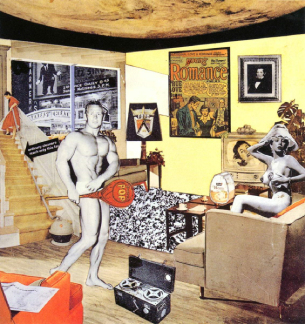I want to show the following images, the first dated from 1656, by Diego Velazquez, and the second from 1956 by the collage artist Richard Hamilton.
The reason I'm showing these images, is to illustrate a particular way in which we use media for artistic self-expression. The two paintings are from very different periods. What they share in common, is an explicit acknowledgement of the media. In Velazquez period, media was usually withdrawn from the process of representation. It was merely a vehicle for achieving immediacy, which is the presence of the represented object(s) in face of the viewer. Of course, this desire for immediacy was never complete, since the complete 'erasure' of the media is impossible.
As a reaction to this, artists started to express themselves not only through the media as carrier of representations to an 'external' world, but through the media itself, as the collage work by Hamilton demonstrates. Contemporary art is marked by the fascination with media, and has moved away from the classic representations of scenes (real or imagined) closer to direct expression through manipulation of the media. This is framed by the concept of hypermediacy. In Velazquez' painting which I show above, hypermediacy is present in the awareness of the process of mediation. Velazquez paints himself in the process of painting the Spanish royal couple, which appear in the mirror, while their daughter stands in the center of the image next to the artist. In the later work of Hamilton, the act of mediation is at the center of the art work, in a more radical way, with its collage of different elements - many of which refer to media items in a culture obsessed with it.



